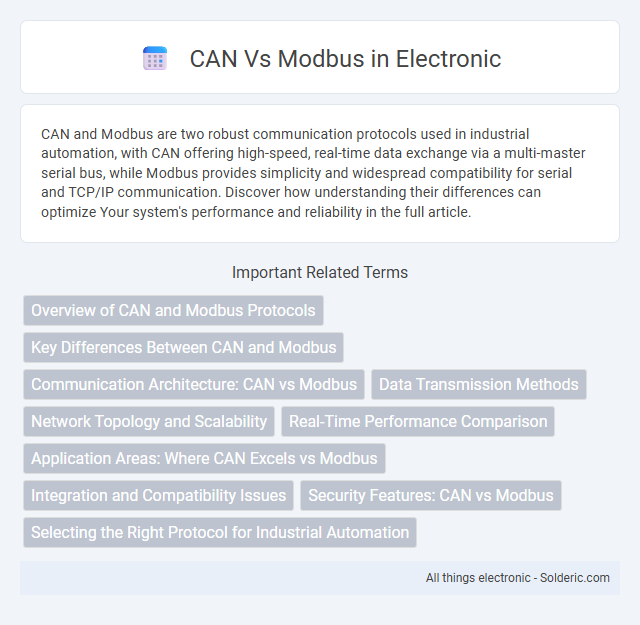CAN and Modbus are two robust communication protocols used in industrial automation, with CAN offering high-speed, real-time data exchange via a multi-master serial bus, while Modbus provides simplicity and widespread compatibility for serial and TCP/IP communication. Discover how understanding their differences can optimize Your system's performance and reliability in the full article.
Comparison Table
| Feature | CAN (Controller Area Network) | Modbus |
|---|---|---|
| Protocol Type | Message-based communication protocol | Master-Slave communication protocol |
| Use Case | Automotive, industrial automation, real-time control | Industrial control systems, PLCs, SCADA |
| Data Rate | Up to 1 Mbps (Classical CAN), Higher in CAN FD | Up to 115.2 kbps (Modbus RTU), Ethernet speeds with Modbus TCP |
| Topology | Multi-master, bus topology | Bus, star, or point-to-point topology |
| Communication | Multimaster with CSMA/CR access method | Master-slave communication |
| Message Handling | Priority-based message arbitration | Request-response communication |
| Error Handling | Error detection with CRC, fault confinement | Error checking with CRC or LRC |
| Addressing | Priority-based message ID, no device address | Device-specific addresses (1-247) |
| Cabling | Twisted pair shielded cable | RS-485 twisted pair for Modbus RTU, Ethernet for Modbus TCP |
| Standard | ISO 11898 | IEC 61158 (Modbus is a de facto standard) |
Overview of CAN and Modbus Protocols
CAN (Controller Area Network) is a robust vehicle bus standard designed for real-time communication between microcontrollers and devices without a host computer. Modbus is a serial communication protocol widely used in industrial applications for connecting electronic devices and transmitting data between PLCs, sensors, and control systems. Understanding the differences in data transmission methods and application environments helps optimize Your network's performance when choosing between CAN and Modbus protocols.
Key Differences Between CAN and Modbus
CAN (Controller Area Network) operates as a robust, multi-master serial communication protocol primarily designed for real-time control in automotive and industrial applications, utilizing message-based transmission with prioritized arbitration. Modbus, in contrast, is a master-slave communication protocol widely used for supervisory control and data acquisition (SCADA) systems, transmitting data in a structured register format over serial or Ethernet networks. Your choice between CAN and Modbus depends on the need for deterministic timing and high fault tolerance (CAN) versus simplicity and compatibility with legacy systems (Modbus).
Communication Architecture: CAN vs Modbus
CAN (Controller Area Network) features a multi-master, message-oriented communication architecture ideal for real-time control systems with high reliability and fault tolerance. Modbus employs a master-slave or client-server architecture primarily designed for simpler, linear data exchanges in industrial automation environments. Your choice depends on whether you need robust, decentralized signaling with collision management (CAN) or straightforward, centralized device communication (Modbus).
Data Transmission Methods
CAN (Controller Area Network) utilizes a multi-master, message-oriented protocol with prioritized arbitration, enabling real-time, fault-tolerant data transmission across a decentralized network. Modbus operates on a master-slave architecture, typically using serial or TCP/IP communication, where the master device initiates all data exchanges, making it suitable for simple, less time-critical applications. Your choice between CAN and Modbus should consider the required transmission speed, network complexity, and robustness against communication errors.
Network Topology and Scalability
CAN networks employ a linear bus topology that supports real-time communication with up to 1 Mbps speed, offering robustness in automotive and industrial applications. Modbus utilizes a master-slave or client-server topology, which can be implemented over serial (RS-485) or Ethernet, allowing for easier scalability and longer communication distances. Your choice between CAN and Modbus should consider the required network size and expansion potential, with Modbus generally providing greater flexibility in large-scale deployments.
Real-Time Performance Comparison
CAN bus offers superior real-time performance with deterministic message delivery and low latency, making it ideal for time-critical automotive and industrial control applications. Modbus, typically implemented over serial or Ethernet networks, exhibits higher latency and is less deterministic, which can hinder precise timing requirements in real-time systems. The priority-based arbitration and error handling of CAN ensure consistent cycle times, whereas Modbus relies on a master-slave communication model that may introduce delays under heavy network traffic.
Application Areas: Where CAN Excels vs Modbus
CAN (Controller Area Network) excels in automotive and industrial automation environments requiring real-time communication with high fault tolerance and robustness. Modbus is primarily used in building automation, energy management systems, and process control where simplicity and wide device compatibility are critical. CAN's superior error handling and prioritization make it ideal for safety-critical applications, while Modbus's ease of integration suits legacy systems and centralized monitoring.
Integration and Compatibility Issues
CAN (Controller Area Network) offers robust integration with automotive and industrial control systems due to its standardized message-based protocol, facilitating inter-device communication without a central host. Modbus, widely used in industrial environments, relies on a master-slave architecture that can create compatibility challenges when integrating devices from different manufacturers or networks using varying communication protocols. Understanding your system's specific requirements is crucial, as compatibility and seamless integration depend heavily on matching the communication standard to your network topology and device capabilities.
Security Features: CAN vs Modbus
CAN (Controller Area Network) offers built-in error detection with features like CRC checks and message prioritization, enhancing data integrity and security in real-time communication. Modbus, especially the traditional serial version, lacks native security mechanisms, making it vulnerable to interception and unauthorized access without additional layers such as Modbus TCP with TLS encryption. For your industrial automation projects, choosing CAN can provide stronger intrinsic security safeguards, while Modbus requires supplementary protocols to ensure robust protection.
Selecting the Right Protocol for Industrial Automation
Selecting the right protocol for industrial automation depends on your system's specific requirements for speed, reliability, and network topology. CAN (Controller Area Network) excels in real-time communication and robust error handling in noisy environments, making it ideal for automotive and factory automation. Modbus offers simplicity and wide industry adoption with easy integration for monitoring and control, but it may lack the real-time performance and fault tolerance that CAN provides.
CAN vs Modbus Infographic

 solderic.com
solderic.com